
Jurassic Spa
manager@naturcosmet.ru
+7 (915) 330-35-96
+7 (915) 330-35-96

Натуральный крем для лица
Тщательно подобранная композиция витаминов, которые усиливают и стабилизируют друг друга, значительно улучшает состояние кожи лица, увеличивает упругость и придает сияющий цвет. Структура крема последнего поколения (ламеллярная эмульсия): надолго увлажняет без образования пленки, проникает на 50% лучше, чем липосомальные крема.
ВИТАМИННАЯ БОМБА для нормальной и комбинированной кожи
Витамин F
из масла конопли усиливает липидный барьер кожи.
Витамины В11 и С
улучшают энергетику клеток, кроме того, витамин С защищает от разрушения витамин Е и сам борется со свободными радикалами.
Витамин Р
(троксерутин) из цитрусовых предохраняет витамин С от окисления и укрепляет стенки сосудов.
Провитамин В5
уменьшает воспаления и раздражения кожи.
Витамин В3
стимулирует кровообращение.
Витамины А и Е
особые антиоксиданты, которые стабилизируют мембраны клеток кожи и предохраняют их от окислительного стресса.
Очанка лекарственная
одержит особый гликозид акубин, который снимает отечность, повышает эластичность стенок сосудов, улучшает кровоснабжение кожи, усиливая действие активных веществ крема.
Лимонник китайский
содержит схизандрин, который восстанавливает активность самого важного внутриклеточного антиоксиданта – глутатиона. Великолепно освежает и оживляет кожу.
Состав
manager@naturcosmet.ru
+7 (915) 330-35-96
+7 (915) 330-35-96
Состав
вода очищенная (Aqua); масло льна (Linum Usitatissimum Seed Oil); витамин F (Linoleic Acid, Linolenic Acid); провитамин В5 (Panthenol); натуральный эмульгатор из глюкозы и растительных масел* (Polyglyceryl-3 Methylglucose Distearate); витамин В3 (Niacinamide); масло рисовых отрубей холодного отжима (Oryza Sativa Germ Oil); витамин С (Ascorbyl Palmitate, Ascorbic Acid) ; витамин В11 (Carnitine); витамин Р (Troxerutin); экстракт очанки лекарственной (Euphrasia Officinalis Extract), экстракт лимонника (Schizandra Chinensis Extract), экстракт корня лопуха (Arctium Lappa Root Extract); масло зародышей пшеницы (Triticum Vulgare (Wheat) Germ Oil); пребиотик** (Sorbitol); натуральный витамин Е (Tocopherols Blend); натрия PCA** (Sodium PCA); фитокератин** (Hydrolyzed Soy and Rice Protein); глицин** (Glycine); молочная кислота** (Lactic Acid); витамин А (Retinyl Acetate), консервант* (Benzyl Alcohol, Benzoic Acid, Sorbic Acid, Glycerin); пищевой ароматизатор яблока (Natural Fragrance).
(*) разрешены европейскими системами экосертификации для органической косметики
(**) компоненты NMF (натурального увлажняющего фактора)
(*) разрешены европейскими системами экосертификации для органической косметики
(**) компоненты NMF (натурального увлажняющего фактора)
Разбор состава
Способ применения
Наносить на предварительно очищенную кожу тонким слоем.
Внимание: возможна индивидуальная непереносимость компонентов.
Внимание: возможна индивидуальная непереносимость компонентов.
Рекомендации
Наука
Исследования
Ниже можно посмотреть некоторые научные статьи, подтверждающие эффективность используемых активов. Слово "Источник" является активной ссылкой, перенаправляющей на первоисточник на платформе PubMed (общемировая платформа научных статей по медицине, биохимии, биологии) или других научных ресурсах.
Мурашкин Н. Н. и др. Инновации в терапии атопического дерматита, осложненного вторичной инфекцией //Педиатрическая фармакология. – 2018. – Т. 15. – №. 4.
Yang M., Zhou M., Song L. A review of fatty acids influencing skin condition //Journal of cosmetic dermatology. – 2020. – Т. 19. – №. 12. – С. 3199-3204.
Spagnol C. M. et al. Ascorbic acid in cosmetic formulations: Stability, in vitro release, and permeation using a rapid, inexpensive, and simple method //Journal of Dispersion Science and Technology. – 2017. – Т. 38. – №. 6. – С. 901-908.
Ravetti S. et al. Ascorbic acid in skin health //Cosmetics. – 2019. – Т. 6. – №. 4. – С. 58.
Ehrlich M. et al. Improvement in the Appearance of Wrinkles with Topical Transforming Growth Factor β1 and l‐Ascorbic Acid //Dermatologic surgery. – 2006. – Т. 32. – №. 5. – С. 618-625.
Trommer H. et al. Role of ascorbic acid in stratum corneum lipid models exposed to UV irradiation //Pharmaceutical research. – 2002. – Т. 19. – №. 7. – С. 982-990.
Kim S., Lee T. G. Stabilization of l-ascorbic acid in cosmetic emulsions //Journal of industrial and engineering chemistry. – 2018. – Т. 57. – С. 193-198.
Raschke T. et al. Topical activity of ascorbic acid: from in vitro optimization to in vivo efficacy //Skin pharmacology and physiology. – 2004. – Т. 17. – №. 4. – С. 200-206.
Stettler H. et al. A new topical panthenol-containing emollient: Results from two randomized controlled studies assessing its skin moisturization and barrier restoration potential, and the effect on skin microflora
Journal of Dermatological Treatment. – 2017. – Т. 28. – №. 2. – С. 173-180.
Journal of Dermatological Treatment. – 2017. – Т. 28. – №. 2. – С. 173-180.
Bissett D. L. Common cosmeceuticals
Clinics in dermatology. – 2009. – Т. 27. – №. 5. – С. 435-445.
Clinics in dermatology. – 2009. – Т. 27. – №. 5. – С. 435-445.
Pavlačková J. et al. In vivo efficacy and properties of semisolid formulations containing panthenol
Journal of cosmetic dermatology. – 2019. – Т. 18. – №. 1. – С. 346-354.
Journal of cosmetic dermatology. – 2019. – Т. 18. – №. 1. – С. 346-354.
Cosmetic Ingredient Review Expert Panel et al. Final report of the safety assessment of niacinamide and niacin
International journal of toxicology. – 2005. – Т. 24. – С. 1-31.
International journal of toxicology. – 2005. – Т. 24. – С. 1-31.
Wohlrab J., Kreft D. Niacinamide-mechanisms of action and its topical use in dermatology
Skin pharmacology and physiology. – 2014. – Т. 27. – №. 6. – С. 311-315.
Skin pharmacology and physiology. – 2014. – Т. 27. – №. 6. – С. 311-315.
Yoshioka A. et al. Anti-oxidant effects of retinoids on inflammatory skin diseases //Archives of dermatological research. – 1986. – Т. 278. – №. 3. – С. 177-183.
Zasada M., Budzisz E. Retinoids: Active molecules influencing skin structure formation in cosmetic and dermatological treatments //Advances in Dermatology and Allergology/Postȩpy Dermatologii i Alergologii. – 2019. – Т. 36. – №. 4. – С. 392.
Słoczyńska K. et al. Skin metabolism established with the use of MetaSite for selected retinoids employed in topical and systemic treatment of various skin disorders and found in cosmeceuticals //Acta Biochimica Polonica. – 2015. – Т. 62. – №. 2.
Ramos-e-Silva M. et al. Anti-aging cosmetics: Facts and controversies //Clinics in dermatology. – 2013. – Т. 31. – №. 6. – С. 750-758.
Packer L., Valacchi G. Antioxidants and the response of skin to oxidative stress: vitamin E as a key indicator //Skin Pharmacology and Physiology. – 2002. – Т. 15. – №. 5. – С. 282-290.
Nachbar F., Korting H. C. The role of vitamin E in normal and damaged skin //Journal of Molecular Medicine. – 1995. – Т. 73. – №. 1. – С. 7-17.
Thiele J. J., Ekanayake-Mudiyanselage S. Vitamin E in human skin: organ-specific physiology and considerations for its use in dermatology //Molecular aspects of medicine. – 2007. – Т. 28. – №. 5-6. – С. 646-667.
Blazics B., Kéry Á. Antioxidant activity of compounds in Euphrasia officinalis L.–revaluation of a traditional medicinal plant //Planta Medica. – 2007. – Т. 73. – №. 09. – С. P_266.
Liu Y. et al. Protective effects of Euphrasia officinalis extract against ultraviolet B-induced photoaging in normal human dermal fibroblasts //International journal of molecular sciences. – 2018. – Т. 19. – №. 11. – С. 3327.
Kopustinskiene D. M., Bernatoniene J. Antioxidant Effects of Schisandra chinensis Fruits and Their Active Constituents //Antioxidants. – 2021. – Т. 10. – №. 4. – С. 620.
Szopa A., Ekiert R., Ekiert H. Current knowledge of Schisandra chinensis (Turcz.) Baill.(Chinese magnolia vine) as a medicinal plant species: a review on the bioactive components, pharmacological properties, analytical and biotechnological studies //Phytochemistry Reviews. – 2017. – Т. 16. – №. 2. – С. 195-218.
Kim S. H., Joo M. H., Yoo S. H. Structural identification and antioxidant properties of major anthocyanin extracted from Omija (Schizandra chinensis) fruit //Journal of Food Science. – 2009. – Т. 74. – №. 2. – С. C134-C140.
Moon J., Lee J. H., You S. Antioxidant Activity and Cytotoxicity on cell of Arctium lappa L. root extract //Journal of the Korean Applied Science and Technology. – 2017. – Т. 34. – №. 1. – С. 41-49.
Chan Y. S. et al. A review of the pharmacological effects of Arctium lappa (burdock) //Inflammopharmacology. – 2011. – Т. 19. – №. 5. – С. 245-254.
Sohn E. H. et al. Anti-allergic and anti-inflammatory effects of butanol extract from Arctium Lappa L //Clinical and molecular allergy. – 2011. – Т. 9. – №. 1. – С. 1-11.
